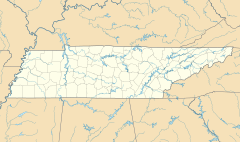Butler, Tennessee facts for kids
Quick facts for kids
Butler
|
|
|---|---|

Buildings along McQueen Street
|
|
| Country | |
| State | |
| County | Johnson County |
| Area | |
| • Total | 0.78 sq mi (2.02 km2) |
| • Land | 0.76 sq mi (1.98 km2) |
| • Water | 0.02 sq mi (0.05 km2) |
| Elevation | 1,995 ft (608 m) |
| Population
(2020)
|
|
| • Total | 297 |
| • Density | 389.25/sq mi (150.34/km2) |
| Time zone | UTC-5 (Eastern (EST)) |
| • Summer (DST) | UTC-4 (EDT) |
| ZIP code |
37640
|
| Area code(s) | 423 |
| FIPS code | 47-10080 |
| GNIS feature ID | 1305567 |
Butler is a small community in Johnson County, located in the northeastern part of Tennessee. It sits along the northern shore of Watauga Lake. Butler has its own post office and uses ZIP Code 37640.
Contents
Discovering Butler's Past
Butler has a long and interesting history. It was first settled way back in 1768. The original town was built where Roan Creek meets the Watauga River.
Early Beginnings of Butler
For many years, the community was known as Smith's Mill. This name came from a gristmill built by Ezekial “Zeke” Smith in 1820. After the American Civil War, the town was renamed Butler. This honored Colonel Roderick R. Butler, who was a local leader and represented the area in the state government.
Education in Old Butler
Education was important in Butler. A school called Aenon Seminary opened in 1871. It later grew into Holly Spring College, which offered college degrees. At one point, it had about 200 students! In 1906, the school was bought by the Watauga Baptist Association and renamed Watauga Academy. This school operated until 1948, when the town was covered by the new Watauga Lake.
Famous People from Butler
Two important U.S. Congressmen were born in Butler. One was B. Carroll Reece from Tennessee. The other was Robert R. Butler from Oregon, who was the grandson of the town's namesake.
The Town That Wouldn't Drown
The original town of Butler often faced serious floods. Major floods happened many times, including in 1867, 1886, and 1940.
Building Watauga Dam
To control these floods and create electricity, the Tennessee Valley Authority (TVA) started building the Watauga Dam in 1942. This dam would create the large Watauga Lake. Construction was paused for a while because of World War II.
Relocating the Entire Town
The dam was finished in 1948. As the water began to rise, the original town of Butler slowly became submerged under the lake. Butler was the only incorporated town completely covered by a TVA lake. Before the lake filled up, the entire town was moved to higher ground. About 600 people lived there, with over 125 homes and 50 businesses.
Moving the town was a huge project! It involved building 54.9 miles (88.4 kilometers) of new roads and highways. Three new bridges were also built. Workers also moved 66 miles (106 kilometers) of utility lines. Even 1,281 graves had to be relocated. The new Butler is located on Tennessee State Route 67.
Remembering Old Butler
The original town is now known as "Old Butler." It's often called “the town that wouldn’t drown.” There's a museum in the new Butler that tells the story of the old town. Each August, a special event called "Old Butler Days" is held to celebrate its history. In 1983, the lake's water level dropped for a short time. This allowed former residents to visit the remains of Old Butler, which was a very special moment for them.
Butler's Population Over Time
| Historical population | |||
|---|---|---|---|
| Census | Pop. | %± | |
| 1910 | 499 | — | |
| 1920 | 578 | 15.8% | |
| 1930 | 706 | 22.1% | |
| 1940 | 608 | −13.9% | |
| 2020 | 297 | — | |
| U.S. Decennial Census | |||
Butler first appeared in the U.S. census in 1910 with nearly 500 people. After the town was flooded in 1948, it didn't appear in the 1950 census. In the 2020 census, Butler was listed as a CDP (a special area for counting population) with 297 people.
Images for kids




